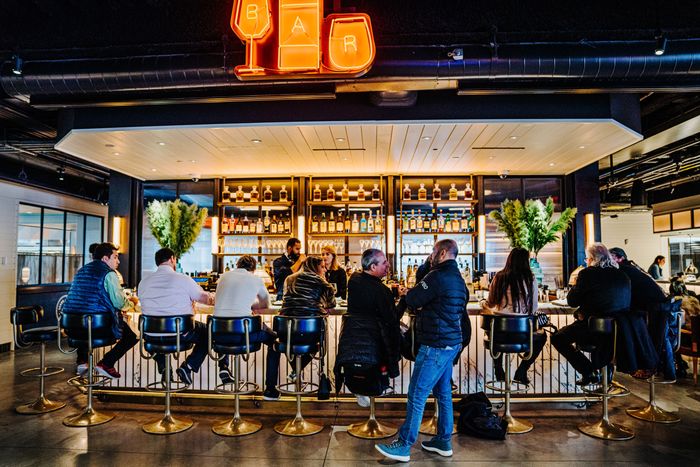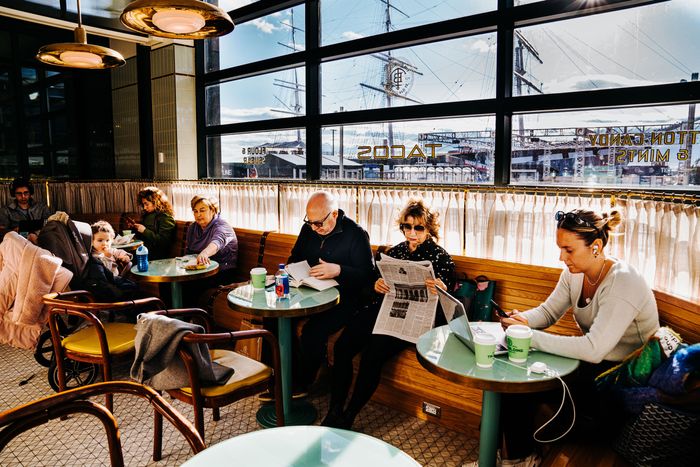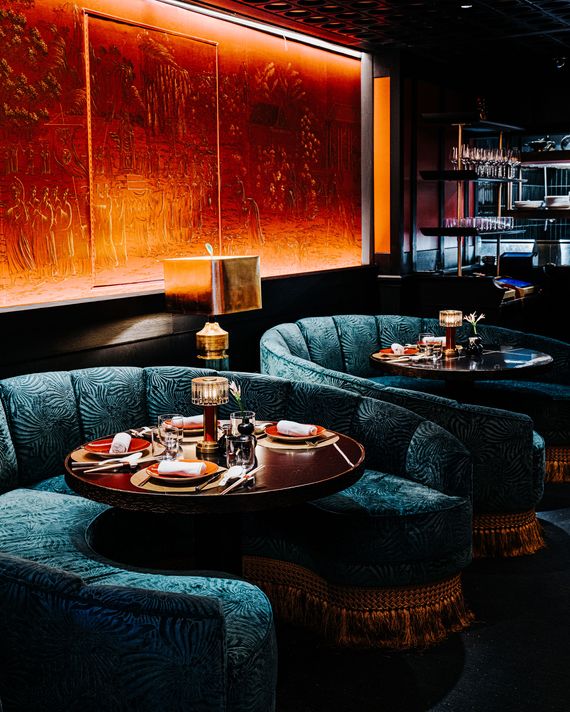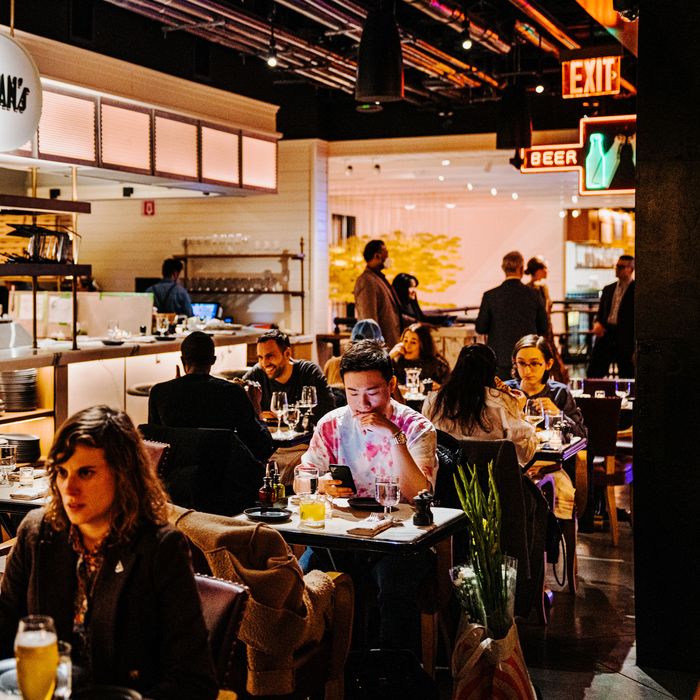
This feels like a restaurant in one of the finer, more empty hotels in Dallas,” my discerning friend muttered as we settled down at Shikku, the sushi-and-sake bar at the Tin Building, Jean-Georges Vongerichten’s new food bazaar at the South Street Seaport. Was this entirely fair? It was the middle of January, when most of gourmet New York is still sunk in a deep postholiday slumber; it was lunchtime, not a prime hour for the haute toro set; and it wasn’t even clear if my friend, a regular at the trendy sushi dens of Tokyo, had spent much time in the grand hotels of northern Texas. But peering around the room, you could see what he meant.
The bar is constructed of black marble and layers of pine, and each empty seat was set, as if from some connect-the-dots sushi manual, with a paper place mat and chopsticks propped on a small black stone. Decorative sake bottles and tea sets were arranged along the walls, and the same jaunty mall tunes that were being piped over the pastry stands and candy shops outside played softly. As each piece of nodoguro and slightly overrefrigerated shrimp followed the next, it felt as though we were being transported from the bustle of Manhattan into that frictionless White Lotus dimension of gleaming hotel lobbies and first-class airport lounges.
This is familiar territory for Vongerichten. With 60 restaurants scattered around the globe in upscale department stores, hotel lobbies, and holiday destinations, he has long been the most adaptable and ingenious of New York’s star chefs. During his eclectic career, he has pioneered lasting culinary trends, such as Asian fusion and the dreaded molten chocolate cake, and perfected many more. Now comes the food court, which is possibly the most challenging genre of all.
The Tin Building isn’t just any food court, however. With a price tag a little below $200 million, it is arguably the single most expensive and ambitious dining project in the history of this restaurant-mad city. There’s a caviar bar within its gilded confines, a working fish market, a boisterous boutique beer garden, a butcher and a cheesemonger, and on and on. Vongerichten and his team of testers spent close to three years sifting through a riot of tastes, flavors, and styles to bring us his idea of the perfect jar of honey, the perfect vinegar — the perfect rendering of almost everything.
Has the great Alsatian chef succeeded in creating his own culinary nirvana on this forgotten patch of downtown real estate? Five months after opening seemed like as good a time as any for a lapsed critic like me to find out while also getting back in touch with my appetites for a bit and maybe even divining a new dining fad or two.
The Shikku lunch came on the second day of a bender I took through the two-story market-and-restaurant complex, during which I’d already enjoyed a surprisingly decent hot pastrami sandwich and a crispy-edged breakfast dosa stuffed with eggs, avocado, and deposits of melted cheese. I’d sipped glasses of dry Muscadet from the Loire Valley and lassis tinged with blueberry and cardamom. I’d ogled small-batch nut oils from Burgundy; admired pots of luxury olive oil designed to be dispensed in little eyedroppers; and learned a new word (wildcrafted) while purchasing a jar of insanely expensive, antioxidant-rich manuka honey from the forests of New Zealand — though what sort of greater theme or purpose these random experiences added up to was hard to ascertain.
I’d also met interesting people, including a former editor for the Daily News named Madeline Rogers, who once served as vice-president of the South Street Seaport Museum and had come south, like me, to see what the fuss was about. She told me that when the original fish market moved out to Hunts Point in the mid-aughts, there were attempts to replace it, most notably with a project called the New Amsterdam Market, which was designed, as Rogers put it, “to save this place from the real-estate devel-opers and what it’s become.”
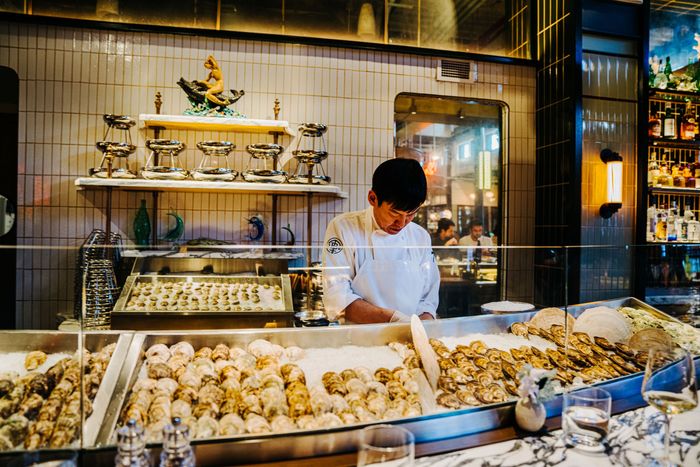
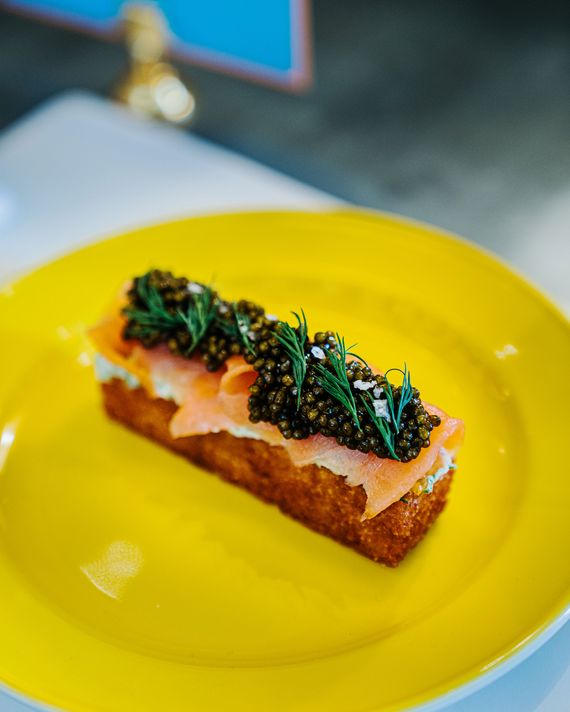
The nonprofit operation had been home to hundreds of local vendors serving items from around the city and the Hudson Valley, Rogers said, along with a variety of festivals and themed events celebrating the historical foods of Old New York. But business was sparse even before Hurricane Sandy devastated the neighborhood. A developer, ominously named the Howard Hughes Corporation, eventually brokered a lease with the city to construct its vision for a new seaport, including a possible marina, a complex of TV studios and restaurants at Pier 17, and the Tin Building, in which we now stood. Officially and aggressively branded as “the Tin Building by Jean-Georges,” it had been raised several feet in case of flooding and fitted with kitchen facilities hidden on the third floor so that everything could be prepared on-site.
Given the exorbitant cost, Rogers said she was surprised to find that the prices for calf’s liver ($12 per pound) and kale ($4) weren’t that bad. She admired the quality of a cookie she’d purchased, too, but she doubted she’d ever return to the market from her distant apartment on the Upper West Side and wasn’t optimistic about its future. “It’s Jean-Georges — of course he’s done a lovely job,” she said, gathering up her goods and heading out into the January gloom. “But really, who shops at the Seaport anymore? We’re at the ass end of nowhere down here!”
Vongerichten, unsurprisingly, had a sunnier view when I met him on another gray weekday. Dressed in pressed kitchen whites with a tan from a recent visit to St. Barts, he looked a little like a sea captain taking a walk on the deck of his own pint-size luxury cruise ship.
As we inspected the glittering displays, shoppers came up with their bags of food to take selfies, and Vongerichten recalled visiting the Seaport back in 1986 while working his first job in New York at the now-vanished Drake Hotel. In the wintertime, fishmongers burned their used crates to keep warm, so the funky harbor air was filled with the smell of woodsmoke. Once, when the manager of the Drake instructed the young cook to drive downtown in search of fresher fish for the evening’s service, Vongerichten returned after his shopping to find the manager’s car jacked up on stilts with the tires gone.
Everything about the neighborhood has changed since then, of course, but if I wanted crowds, Vongerichten said, Ishould come on a weekend or during the tourist-friendly summer season, and in any case, the market was still a work-in-progress; he was adding new products and dishes every day. He’d taken inspiration from the famous food hall at Harrods in London and the culinary emporiums in the grand department stores of Tokyo, he said. The idea of the Tin Building, with its combination of sit-down establishments and walk-up counters like Double Yolk — which serves egg sandwiches and a burger by day and turns into a caviar bar at night — was to have “something for everyone at any time of the day.”
Vongerichten, who will celebrate 50 years in the restaurant business in July, said that though his eponymous flagship in midtown was “thriving,” he thought that, these days, you need a wider variety of styles and price points to lure a younger crowd. “In-between dining,” he called it. In the future, destination-oriented consumption would be less about a single, distant, impossible-to-reserve table at a place like Noma or El Bulli than about Tony Bourdain–style rambles through regions and cities, and the best way to try to replicate that would be with “culinary markets” like the Tin Building.
A perfectly steamed cup of cappuccino appeared as we walked along, procured by a member of the staff, which has grown to nearly 700. Vongerichten wanted me to know that for every vessel of designer sesame oil on the shelves, ten more didn’t make the cut. I won’t pretend that I tasted everything during my trek through the chef’s vision for the future, though I did my best. Double Yolk seemed like a lonely place in both the morning and the evening, and I’m not sure my fat scrambled-egg-and-ham sandwich was worth its $13 price. If you happen to find yourself in the bakery and pastry zone on the ground floor, however, you could do worse than the $4 candied-banana cookie or the squeezy, millet-crusted squash bread, several slices of which are entombed in my freezer back home.
The chef was also right about the weekend crowds, which were so thick on a recent Sunday morning that my daughter and I were turned away from the strangely named pizza destination the Frenchman’s Dough (“Italian with a twist”) and the French-themed T. Brasserie (“I’m sorry, sir, our next table is in three hours”). We finally found refuge at Seeds & Weeds, a casual version of Vongerichten’s vegetarian restaurant, abcV, where the airy, wood-toned room featured chairs webbed with coils of rope and matcha-colored banquettes. We sipped refreshing beet-juice elixirs and grazed on sweet-potato dumplings and long, curling dosas garnished with sambal and eggs. Afterward, we drifted through the markets, pricing things that we would probably never buy (Tin Building–branded oven mitts, giant bags of raw macadamia nuts, eucalyptus-scented soy-wax candles), the way you do when you’re killing time in the lobbies of fancy hotels.
I never purchased any of the sausages or cuts of beef that were enticingly laid out at the butcher’s on the ground floor next to a decorative and very dead piglet that seemed to stare at me accusingly day after day, though I’m sure they’re delicious. The same goes for the shiny pomegranates, organic avocados, and two types of dragon fruit (red and white) that you can buy at the grocer. I can vouch for the smooth Tin Building Medium Roast No. 2 coffee beans, however, neatly packaged like the Tin Building chocolate pretzels, and any number of other Tin Building products, in a box stenciled with the operation’s distinctive gold anchor logo.
If the beer bar upstairs were five or even ten blocks from my apartment, I’d return to watch European football games in the middle of a lazy weekday afternoon with a hazy pint of IPA and what may be the finest faintly sweet, fresh-baked Alsatian-style pretzel in town. The same goes for the thin-crust arugula-and-crushed-tomato pizza and for Vongerichten’s seafood bar, where you can find what someone described as elegant “Jean-Georges lite” interpretations of old seaside favorites like fried clams, fish and chips, and an exceptional clam chowder choked with minutely diced potatoes and bits of smoked bacon and touched with a trademark hint of coconut milk.
Compared with the other food halls around town, the restaurants are better than Eataly’s, but the shopping is not, and you don’t get the sense of focused terroir that you do at the new Singapore-themed Urban Hawker in midtown or at José Andrés’s Mercado Little Spain at Hudson Yards. In the end, the most emblematic venue at this well-executed, strangely located complex may be the place I celebrated the end of my culinary odyssey: the Chinese-themed House of the Red Pearl, which you will find on the second floor behind a thick curtain at the back of an Asian-condiments store.
With its plush and dimly lit interior — lantern-shaped chandeliers, felt banquettes, and ye olde colonial pagoda scenes on the walls — the room reminded me of the kind of expat fantasia you used to see off the lobbies of hotels throughout Asia back in the 1980s, when I lived in Hong Kong and young Vongerichten was chef de cuisine at the Oriental Hotel in Bangkok.
As opposed to the crowded menus several blocks north in Chinatown, this one was short on choices and featured old tourist favorites: Sichuan mala chicken; a steamy, mushroom-rich hot-and-sour egg-drop soup; and Cantonese-style lobster tossed with scallions and chewy, fresh-made “longevity” noodles. There was nothing wrong with any of them when taken separately, including the cartoon-size, TikTok-friendly fortune cookie at the end of the meal. But like lots of my experiences at the Tin Building, there was no sense of context or continuity, either, and as I wearily took pictures of the giant cookie with my sauce-stained phone, it felt as if we were at some VIP Disney restaurant, or a discreet high-roller noodle den at a Vegas casino, or onboard a cruise ship bobbing out on the ocean, a thousand miles from home.



